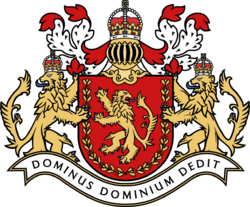Home Service (Great Nortend)
This article is incomplete because it is pending further input from participants, or it is a work-in-progress by one author. Please comment on this article's talk page to share your input, comments and questions. Note: To contribute to this article, you may need to seek help from the author(s) of this page. |
| Home Service | |
|---|---|
 | |
| Active | 8 June 1936 — |
| Country | |
| Role | Civil and military defence |
| Insignia | |
| War Cross | |
| Red Ensign | |
| Blue Ensign | |
His Majesty's Home Service consists of the combined reserve military forces of Great Nortend. The Home Service is divided into three divisions, being the Home Force, the Home Fleet and the Home Flight, serving as the reserve counterpart to the Royal Army and the Navy Royal's Sea Fleets, and Air Flight respectively. It is tasked principally with the defence of the Realm, rather than offensive actions. It also trains to assist the civil forces in responding to civil emergencies such as fires, floods, storms and riots within their areas of expertise.
The Home Service is mainly manned by part-time voluntary home servicemen in civilian occupations who participate in military training and activities on a part-time basis after full-time muster service. Servicemen are obliged to attend weekly parade or drill nights as well as four week-end bivouacs and up to a fortnight of training programmes annually.
Owing to their role as home and civil defence, home servicemen have never been deployed abroad in offensive combatant roles and are thus nicknamed the “Marching Boys”, or the “Boys in Brown” in reference to the brown duty uniforms (compared to the coloured formal uniforms worn in public by regular and muster servicemen).
History
The Defence of the Realm Act 34 Edm. IX established the modern-day Home Service in 1936 after deficiencies in the existing home defence was raised in the Great Astyrian War. The Act restructured and combined the former locally raised militias, yeomanries, volunteer corps, naval merchant marine and air reserve forces. The resulting two services, the Home Force and Home Fleet, were placed under the command of the War Office.
In 1946, the Act was amended to reform the system of conscription and home service in response to the heavy burden it placed on young workers and their families. In 1960, with the establishment of the Air Flight as a distinct sub-unit of the Navy Royal, a Home Flight was carved out of the Home Fleet as a similar distinct sub-unit for air capability.
Organisation
The Home Service is organised at a local level. Several troops of the Home Force from a particular region are grouped together as a company, and often undertake exercises together. Several companies form a district and several districts form a militia battalion, which is a county-sized formation. This is analogous to the structure of the King's Cadet Corps, the youth equivalent of the Home Service.
The Home Fleet and Flight are structured similarly, albeit built around the company structure rather than on smaller troops or platoons.
Civil response
The Home Service is often the first responders to civil emergencies such as fire, flooding and storms. For instance, servicemen are trained to use and operate hydrants and fire engines when professional firemen have yet to arrive. They are also trained to assist the police and also to perform first aid, amongst other things.
The Home Service shifted its focus after the 2007 Whenton Report back to its original principles of local military and civil defence after a slow decline in their military role leading to some platoons even regularly leaving rifles at home. Since 2008, Home Service companies have participated in regular major exercises domestically and abroad. Furthermore, they retain their on-going responsibility for the defence of critical local infrastructure such as water works, gas plants and electricity mills, as well as response in emergency scenarios such as fire, severe flooding, snowfall, storms, riot or invasion.
Manpower
Home Service units have a wide mix of ages, from young men fresh out of muster service to retired regular troops. After compulsory muster service, men may voluntarily choose to serve in the Home Service. Those exempt from muster may also voluntarily join the Home Service.
Home servicemen normally wear duty, deck,field or working dress at on service. Unlike active troops, home servicemen do not wear their uniform when “walking out”. Additionally, uniforms have shoulder patches with the words, “Home Service”. Uniforms additionally have troop, company and battalion patches where applicable.
Home servicemen are not paid for their service, except to cover costs and sometimes, for lost wages when on exercises.
Requirements
A person is required to fulfil the following criteria to be eligible to join the Home Service :—
- Full Erbonian subjectship.
- Between 18 and 35.
- Of sound and sobre character.
- Physically able.
- Military disposition.
- Of the Church of Nortend.
There is no maximum age limit for service; however, a home serviceman will be forced to retire or leave if he fails to maintain sufficient physical ability to service in the Home Service. A home serviceman must also be able to fulfil his obligations to the Home Service.
This page is written in Erbonian English, which has its own spelling conventions (colour, travelled, centre, realise, instal, sobre, shew, artefact), and some terms that are used in it may be different or absent from other varieties of English. |



